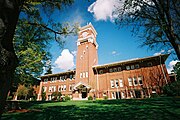Martin Stadium
 Aerial view of the Martin Stadium from the northeast, taken in March 2024 | |
 | |
Location in theUnited States Location inWashington | |
| Address | 720 NE Stadium Way Pullman, Washington United States |
|---|---|
| Location | Washington State University |
| Coordinates | 46°43′55″N117°09′36″W/ 46.732°N 117.160°W |
| Elevation | 2,510 feet (765 m)AMSL |
| Owner | Washington State University |
| Operator | Washington State University |
| Capacity | 32,952 (2014–present)[1][2][3][4][5][6][7] |
| Surface | FieldTurf:(2000–present) Omniturf:(1990–1999) SuperTurf: (1979–1989) AstroTurf:(1972–1978) |
| Construction | |
| Broke ground | January 1, 1972[8] |
| Opened | September 30, 1972 |
| Renovated | 1975, 1979, 1999, 2006, 2012 |
| Expanded | 1975: north grandstand 1979: track removed 2012: premium seating |
| Construction cost | $1 million ($7.28 million in 2024[9]) $150 million (renovation) |
| Architect | Naramore Bain Brady & Johanson[10] |
| General contractor | Halvorson–Berg[11] |
| Tenants | |
| Washington State Cougars(Pac-12,NCAA) (1972–present) Idaho Vandals(NCAA) (1999–2001) | |
| Website | |
| Martin Stadium | |
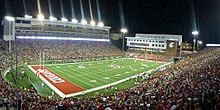
Martin Stadiumis an outdoor athleticstadiumin theNorthwestern United States,on the campus ofWashington State UniversityinPullman, Washington.It is the home field of theWashington State Cougarsof thePac-12 Conference.
Its full name isGesa Field at Martin Stadiumdue toRichland-based Gesa Credit Union signing a 10-year sponsorship deal in 2021 for the playing surface; it has usedartificial turfsince its inception in1972,with infilledFieldTurfused since2000.
History
[edit]The stadium is named afterClarence D. Martin(1886–1955), thegovernor of the state of Washington(1933–41), a former mayor ofCheneyand 1906 graduate of the University of Washington.[12]His son, Dan (Clarence D. Martin, Jr., 1916–1976),[13]made a $250,000 donation to the project in January 1972 under the stipulation that the stadium be named after his father.[14][15][16]Additional gifts were continued by Dan's widow, Charlotte Martin; $250,000 in 1978 and $150,000 in 1979.[17][18]
Martin Stadium opened 52 years ago in1972on September 30, with a 19-point loss toUtah,then a member of theWAC,[19][20]with 20,600 in attendance.[21]Two and a half years had passed since the south grandstand and press box of its predecessor, the woodenRogers Field,was significantly damaged by fire, a suspected case ofarson.[22]The WSU Cougars played all of their home games atJoe Albi StadiuminSpokanein1970and1971.[23]Aside from those two years, the Cougars have played at the site of Martin Stadium since 1895.
In its first season in 1972, only the south grandstand, press box, lights, and artificial turf were new; the remaining sections from Rogers (north sideline and east end zone) were replaced later.[11][24][25]Theseating capacityin 1972 was 22,600;[6][7]the wooden north stands were demolished after the1974season,[26][27][28]and the new concrete grandstand expanded the seating to 26,500 for 1975.[5](1975 aerial photo)[29]The east end zone seats from Rogers were finally replaced in1999.[30][31]The stadium has an unorthodox east–west alignment; north-south is conventional (e.g. Joe Albi).
After renovations in2003,seating capacity was reduced to 35,117, and was 32,952 in2014.[1]Since the expansion ofReser StadiumatOregon Statein2005,Martin Stadium fell to last in football seating capacity in the Pac-10, and is last in thePac-12.The current attendance record was set during the championship year of1997,when WSU beatStanfordon Senior Day in front of 40,306 on November 15.[32][33](They won theApple CupatHusky StadiuminSeattlethe following week to win the Pac-10, and played in theRose Bowlfor the first time in67 years.)[34]
Despite its relatively small size, Martin Stadium has one of the highest ratios of seating capacity to population base; almost 1.1 seats per every citizen in the city of Pullman, and one for most inWhitman County.Following a 10–3 season and an undefeated home campaign in2003,it was ranked bySports Illustratedas one of the toughest stadiums for visiting teams incollege football.[citation needed]
On March 12, 2021, WSU announced that the Washington State Board of Regents had approved a 10-year, $11 million minimum deal with Gesa Credit Union, aRichland-based financial institution, to sponsor the playing surface at the stadium. The deal had the surface renamed toGesa Field;it did not includenaming rightsto the stadium.[35][36]
1979 expansion
[edit]Martin Stadium was among the firstcollege footballstadiums to expand by removing its 440-yard (402 m) running track and lowering the playing field, in this case by 16 feet (5 m). This modification in1979added over 12,000 new seats, most of which were closer to the field (and the opponent's bench).[5][37][38][39]The first game following the renovation was played in mid-October,[40]a17–14victory overUCLAunder sunny skies.[41]
The Mooberry Track was constructed north of the stadium, then the site of the old Bailey baseball field, with home plate at the northwest corner. Baseball was relocated northeast, toward thegolf course,toBailey–Brayton Field.The original plan was for the track to occupy that space, but soil issues caused a revision.[42][43]The new track debuted in the spring of 1980 and hosted its first event on May 3, a decisive dual-meet win over rival Washington.[44][45]
2006–2014 renovations and transformation
[edit]Phases I and II (2006–2008)
[edit]Phases I and II commenced at the end of the 2006 football season. The project focused on improving the public areas in and around the stadium. A new concourse was built along the north stands and new concessions and restrooms were also added throughout the stadium. Improvements were also made around the stadium perimeter including the construction of a new public plaza and ticket office at the stadium's northeast corner along with a monumental sign at the east edge of the stadium along Stadium Way. The existing scoreboard behind the west stands was also upgraded.[46]
Phases III and IV: The Cougar Football Project (2011–2014)
[edit]Phases III and IV were branded asThe Cougar Football Projectand consisted of two major projects, and additional improvements in a smaller projects that followed.
The first project, called theSouthside Project,was an $80 million project that replaced the old press box on the south stands with a new structure that includes a new press box, club seats, loge boxes, luxury suites and a club room. Approximately 1,900 new seats were added in the premium seating area. The expansion also added 21 luxury suites (four, 24-person; nine, 18-person; and eight, 12-person), 42 loge boxes (27, four-person and 15, six-person) and approximately 1,300 club seats (1,200 outdoor and 100 indoor). The former press box did not have the amenities necessary for "first class" game productions with respect to national television and radio broadcasts as provided for in the new Pac-12 television and media contract. The Southside Project began demolition and construction in November 2011 and was completed by the first game of the2012season.

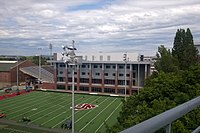
The second project, called theWest End-Zone Project,was a $61 million project that provided a new football operations center for the Cougar football program, including new weight/locker rooms, equipment and training areas for players. In addition to meeting rooms and coaches' offices, it will also feature a WSU football heritage area and a game-day home for former letter winners. The project was approved in November 2012, and construction began that month on November 26. This project was completed for the opening of the2014season. Additional improvements included A/V and architectural upgrades to the stadium. In response to the West End-Zone Project occupying the space where the scoreboard had been, a new video display was installed on the stadium's east end. It measures 73 by 36 feet (22 m × 11 m) and features the latest light emitting diode (LED) video technology. The video board is 112% larger than the previous board while producing a wider, more consistent viewing angle. The video display is more than double the size of the previous display with four times the resolution. It is one of the fewHD VideoDisplays in college football as its 1708 x 840 resolution exceeds theHDstandard. The project also included the installation of an LED Ribbon Board that measures four feet (1.2 m) tall by 347 feet (106 m) wide and runs along the length of the premium seating side. A ribbon board was then added above the north stands in 2014. Both the video and ribbon boards display game statistics and information, out of town scores, along with graphics, animations, crowd prompts, and opportunities for partner-related elements. A new custom audio system, which is integrated with the video and scoring system, was also installed and engineered to provide full-range sound reproduction and deliver clear and intelligible speech at Martin Stadium.
In time for the 2014 season, the concrete wall that separated the playing field from the stands was faced with brick, and galvanized steel railings painted black to give the stadium a more traditional feel and to architecturally integrate with the exterior finish materials used on the new Cougar Football Complex.
Playing surface
[edit]The current playing surface is Revolution Fiber byFieldTurf,installed in the summer of2014as part of the budget inclusion for the $61 million Football Operations Building. Rev Fiber is the latest and most realistic grass-like surface available, also used atOhio StateandNotre Dame,and theNFL'sLumen FieldandGillette Stadium.Rev Turf has received aFIFA2-star rating forsoccer.
FieldTurfwas first installed in2000[47]and replaced in2006,[48]preceded by thesand-filledOmniturfof1990.[49]The original playing surface at Martin Stadium in1972wasAstroTurf,replaced by SuperTurf in1979,[50][51][52]and again in1984.[53][54]The playing surface atRogers Fieldwas natural grass. Theelevationof the field is approximately 2,510 feet (765 m) abovesea level,which was the highest in the Pac-10, but is a distant third in the Pac-12.
Goalposts
[edit]Martin Stadium is one of only three in theFBS(formerly Division I-A) which uses goalposts with two support posts for all of its home games. The others areDoak Campbell StadiumatFlorida StateandTiger StadiumatLSU.Single-support goalposts were torn down at Martin Stadium in1982and1988,afterApple Cupvictories.[55][56][57]
The double posts at Martin debuted with the Omniturf in 1990.[49]The distance between the uprights was narrowed for college football in1991to 18 ft 6 in (5.64 m), matching the NFL.[58]
Apple Cup
[edit]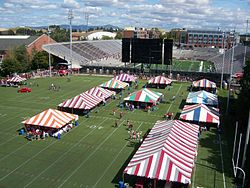
directly west of Martin Stadium

between the 2006 and 2012 renovations.
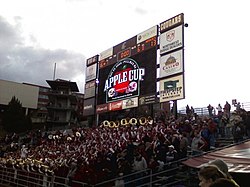
Washington State hosts theApple Cuprivalry game withWashingtonin even-numbered years. Except for1954,the Apple Cup was played atJoe Albi StadiuminSpokanefrom 1950 to 1980, rather than in Pullman. The Cougars went 3–12 (.200) in these fifteen Spokane Apple Cups (winning in1958,1968,and1972), while winning the previous two games played in Pullman (1948,1954).
Since1982,a Cougar victory, all WSU home games in the rivalry have been played at Martin Stadium, with the Cougars winning seven of the 19 Pullman games (.368) through2018;the most recent win was in2012,in overtime.
Sharing with a rival
[edit]For2+1⁄2seasons,1999–2001,theIdaho Vandalsof nearbyMoscowborrowed Martin Stadium to use as its home field,[60][61]as Idaho transitioned fromDivision I-AAback up to I-A. At the time, the Vandals'Kibbie Domewas too small to support theNCAA'sattendance requirements forDivision I-A.[62]
The attendance criteria were changed, and Idaho has used the Kibbie Dome as its football home ever since. The Vandals continued as an FBS member through the 2017 season, after which they returned to FCS play in theBig Sky Conference,which the rest of the Idaho athletic program had rejoined in 2014.
Washington State and Idaho renewed their dormant football rivalry in1998,and matched up annually in theBattle of the Palousefor a decade. The game was played at Martin Stadium in September, although the2003game was played far from the Palouse, 300 miles (500 km) west at year-old Seahawks Stadium, now known asLumen Field,inSeattle.[63]After a ten-year renewal, the Vandal head coachRobb Akey,a former WSUdefensive coordinator,stated that he preferred the game not be played every year.[64]The regular series ceased again after2007;they met in2013and2016,and a game scheduled for 2020 was canceled due to the pandemic.
Fire at Rogers Field
[edit]At 10:30 p.m. on Saturday, April 4,1970(the first day ofSpring break), residents heard what they described as a gunshot at thefootball stadium.By 2:00 a.m., the south grandstand and press box of the 1930s wooden venue had burned to the ground, witnessed by a thousand residents and firefighters.[22]The exact cause, or offender, was never found, though there were several suspects.
The Cougars played their entire home schedule for the1970and1971football seasons atJoe Albi StadiuminSpokane.The fire also displaced theIdaho Vandals,whose woodenNeale Stadiumwas condemned before the1969season (and set afire byarsonthat November). The Vandals had used WSU's Rogers Field for its threePalousehome games in 1969 and were planning to use it again in for four home games in1970.Without another suitable stadium in the Moscow-Pullman vicinity, Idaho played its 1970 home schedule at the reduced capacity Rogers Field, returning to itsMoscowcampus in October1971.The 1970 WSU-Idaho game in Spokane on September 19 was dubbed "The Displaced Bowl", and was easily won by the Cougars,44–16,their only victory of the season.[65][66]
The name "Rogers Field" continues on campus, transferred to areas used forintramuralsports and football practices, west of the stadium.[59]
Tradition
[edit]The public address announcer at Martin Stadium is Glenn Johnson, a professor emeritus at WSU who is also the mayor of Pullman. Johnson is known for his first-down call of "...and that's ANOTHER Cougar first down!" In recent years, the crowd has chanted "...COUGAR FIRST DOWN!" in unison along with Johnson.[citation needed]
See also
[edit]References
[edit]- ^ab"2014 Washington State Football Media Guide"(PDF).Washington State Athletics.RetrievedAugust 25,2014.
- ^"2013 Gameday at Washington State"(PDF).Washington State Athletics.RetrievedAugust 22,2013.
- ^Stalwick, Howie (August 14, 2012)."Stadium a Little Bigger, Way Better for Cougars".The News Tribune.Tacoma. Archived fromthe originalon February 4, 2013.RetrievedSeptember 8,2012.
- ^Washington State Weekly Release - Game 9 at California
- ^abc"Hanson directs stadium drive".Spokesman Review.Spokane, Washington. p. 19.
- ^ab"About 20,000 expected as WSU" comes home "".Spokane Daily Chronicle.Washington. September 29, 1972. p. 15.
- ^abMissildine, Harry (September 30, 1972)."Good news for Cougars, Utes, fans in stadium opener".Spokesman=Review.Spokane, Washington. p. 10.
- ^"Stadium Nearer to Reality".The Cheney Free Press.December 9, 1971. p. 11.RetrievedAugust 22,2013.
- ^1634–1699:McCusker, J. J.(1997).How Much Is That in Real Money? A Historical Price Index for Use as a Deflator of Money Values in the Economy of the United States: Addenda et Corrigenda(PDF).American Antiquarian Society.1700–1799:McCusker, J. J.(1992).How Much Is That in Real Money? A Historical Price Index for Use as a Deflator of Money Values in the Economy of the United States(PDF).American Antiquarian Society.1800–present:Federal Reserve Bank of Minneapolis."Consumer Price Index (estimate) 1800–".RetrievedFebruary 29,2024.
- ^Capital Planning and Development Reports
- ^ab"Phase nears end on stadium work".Spokane Daily Chronicle.Washington. February 29, 1972. p. a3.
- ^Moore, Jim (May 10, 2005)."Go 2 Guy: 'The big ugly secret' of WSU's stadium".The Seattle Post-Intelligencer.Archivedfrom the original on September 29, 2007.RetrievedSeptember 30,2022.
Did Washington State Coug it when it named Martin Stadium 35 years ago? Or is everyone all right with the fact that Clarence D. Martin was a Husky? Gene Miller isn't. The '68 Wazzu grad wants to rename it Randall Johnson Stadium in honor of the 90-year-old Coug who designed the WSU logo in 1936. On the city of Cheney's Web site, Miller discovered that Martin, Washington's governor from 1932-40, graduated from the U Dub in 1906.
- ^"Guide to the Clarence Daniel Martin, Jr. Papers 1916-1976 Cage 449".Washington State University Libraries.RetrievedFebruary 17,2013.
- ^Missildine, Harry (January 22, 1972)."It'll be 'Martin Stadium'".Spokesman-Review.Spokane, Washington. p. 10.
- ^Bond, Rowland (January 21, 1972)."$250,000 Given WSU".Spokane Daily Chronicle.Washington. p. 1.
- ^"Stadium bids are opened at Pullman".Spokesman-Review.Spokane, Washington. January 28, 1972. p. 1.
- ^"L.A. donor pledges large gift for stadium expansion".Spokesman-Review.(Spokane, Washington). October 19, 1978. p. 18.
- ^"Stadium project gets new money backing".Spokane Daily Chronicle.Washington. August 7, 1979. p. 17.
- ^Brown, Bruce (October 2, 1972)."Mistakes sink Cougars".Spokane Daily Chronicle.Washington. p. 21.
- ^http://cfbdatawarehouse.com/data/active/w/washington_state/1970-1974_yearly_results.phpArchived2018-10-10 at theWayback Machine– WSU results – 1970–74
- ^Missildine, Harry (October 1, 1972)."Utah Beats Cougars 44-25".Spokesman-Review.(Spokane, Washington). p. 1, sports.
- ^ab"Fast Blaze Ruins Pullman Stadium".Spokesman-Review.Spokane, Washington. April 6, 1970. p. 1-sports.
- ^Leeson, Fred (December 19, 1971)."Stadium to proceed".Spokesman-Review.(Spokane, Washington). p. 6.
- ^"Aerial view of Martin".Spokesman-Review.(Spokane, Washington). (photo). October 3, 1972. p. 17.
- ^"Martin Stadium ready".Spokane Daily Chronicle.(Washington). (photo). September 29, 1972. p. 15.
- ^Felgenhauer, Neil (March 8, 1974)."Stadium to seat more".Spokane Daily Chronicle.(Washington). p. 1.
- ^"Stands demolished".Spokane Daily Chronicle.(Washington). November 21, 1974. p. 1.
- ^"Pre-cast for Cougars".Spokane Daily Chronicle.(Washington). June 10, 1975. p. 24.
- ^"Moscow & Pullman set progressive pace in Palouse country".Spokesman-Review.(Spokane, Washington). (Sunday Magazine). December 27, 1975. p. 28.
- ^McDonough, Ted (March 6, 1999)."Regents OK new bleachers for stadium".Moscow-Pullman Daily News.(Idaho-Washington). p. 4A.
- ^Strickland, Carter (April 14, 1999)."Stadium renovation".Spokesman-Review.(Spokane, Washington). p. C2.
- ^Sando, Mike (November 15, 1997)."Cougars stack deck with a full house".Spokesman-Review.Spokane, Washington. p. C1.
- ^Rockne, Dick (December 26, 1997)."From Pullman to Pasadena – Cougars on a roll".Seattle Times.RetrievedNovember 1,2014.
- ^"A Wazzu bouquet".Spokesman-Review.Spokane, Washington. November 23, 1997. p. A1.
- ^Lawson, Theo."Gesa Credit Union, Washington State agree to 10-year, minimum $11 million sponsorship deal for naming rights of Martin Stadium playing surface".The Spokesman-Review.RetrievedMarch 13,2021.
- ^"Washington State lands naming rights deal for stadium field".Associated Press. March 12, 2021.
- ^"Martin Stadium on schedule".Spokesman-Review.Spokane, Washington. April 1, 1979. p. C3.
- ^"Construction to start".Spokesman-Review.Spokane, Washington. December 21, 1978. p. 27.
- ^"New Martin Stadium".Spokane Daily Chronicle.Washington. (photo). September 7, 1979. p. 1.
- ^Van Sickel, Charlie (October 12, 1979)."Major questions face WSU in UCLA clash".Spokane Daily Chronicle.p. 25.
- ^Van Sickel, Charlie (October 15, 1979)."Kicking, defense WSU keys".Spokane Daily Chronicle.Washington. p. 23.
- ^Ernst, Cheryl (July 9, 1979)."WSU stadium costs disputed".Spokesman-Review.Spokane, Washington. p. 11.
- ^Van Sickel, Charlie (January 8, 1980)."Track standouts may desert Washington State".Spokane Daily Chronicle.Washington. p. 15.
- ^"Cougars face Huskies".Spokane Daily Chronicle.(Washington). May 2, 1980. p. 21.
- ^"Tiny Coug vaulter sharp in win over Huskies".Spokane Daily Chronicle.(Washington). May 5, 1980. p. 27.
- ^"Phase III of stadium targets luxury seating".WSU News.WSU News/University Communications Office.Retrieved9 July2016.
- ^Blanchette, John (August 11, 2000)."Friendly turf".Spokesman-Review.(Spokane, Washington). p. C1.
- ^Frank, Robert (June 2, 2006)."Returfing Martin Stadium".WSU Today.RetrievedJune 25,2012.
- ^abMiedema, Laurence (June 14, 1990)."Sewing the seeds for greener pastures".Lewiston Morning Tribune.(Idaho). p. 1B.
- ^Martin Stadium at wsucougars.com
- ^"New Martin Stadium".Spokane Daily Chronicle.(Washington). September 7, 1979. p. 1.
- ^"New turf's on schedule".Spokane Daily Chronicle.(Washington). June 22, 1979. p. 15.
- ^Morlin, Bill (February 1, 1984)."Battelle to study hardness of artificial turf samples".Spokane Chronicle.(Washington). p. 5.
- ^Bergum, Steve (April 11, 1990)."Washington State seeks bids for turf at Martin Stadium".Spokesman-Review.(Spokane, Washington). p. D7.
- ^Devlin, Vince (November 23, 1982)."Receivers, corners top priority".Spokane Daily Chronicle.Washington. p. 17.
- ^Sorensen, Eric (November 16, 1990)."WSU to boost Apple Cup security".Spokane Chronicle.Washington. p. A1.
- ^Sorensen, Eric (November 19, 1992)."Strong defense key to Apple Cup plans".Spokesman Review.Spokane, Washington. p. B4.
- ^Conrad, John (August 21, 1991)."They'll have something to kick about".Eugene Register-Guard.Oregon. p. 1B.
- ^abMcCartan, Richard (January 20, 2002)."Remembering Rogers Field".Cougfan.com.Archived fromthe originalon September 29, 2011.RetrievedOctober 23,2011.
- ^"Vandals, Cougars sign Martin Stadium deal".Spokesman-Review.Spokane, Washington. June 22, 1999. p. C5.
- ^Meehan, Jim (September 15, 1999)."Call it what you want, Martin Stadium not home".Spokesman-Review.Spokane, Washington. p. C5.
- ^Meehan, Jim (November 11, 1998)."Vandals bid Kibbie Dome farewell until...?".Spokesman-Review.Spokane, Washington. p. C5.
- ^"WSU vs. Idaho Records".Archived fromthe originalon 2011-09-28.Retrieved2007-09-02.
- ^Smith, Craig (December 21, 2006)."Akey Talks of Commitment at Idaho".The Seattle Times.RetrievedOctober 23,2011.
- ^"WSU results - 1970-74".Archived fromthe originalon 2011-09-28.Retrieved2007-05-08.
- ^Fry, Richard B. (March 17, 2004)."The Smilin' Irishman".Cougfan.com.Archived fromthe originalon October 2, 2013.RetrievedOctober 23,2011.
External links
[edit]- Official website
- World Stadiums.com– photos – Martin Stadium



